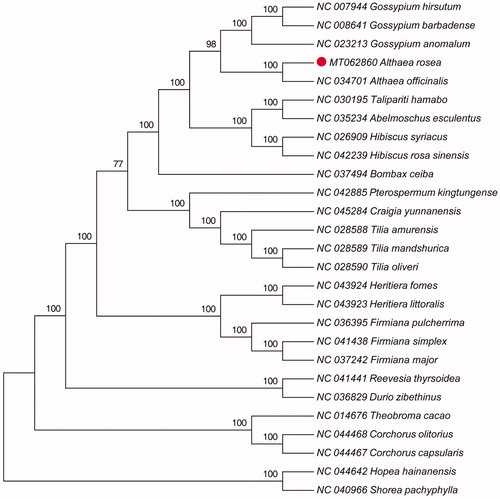Abstract
Althaea rosea is a medicinal plant traditionally used in anti-inflammation. In this study, we characterized the complete chloroplast (cp) genome sequence of A. rosea to investigate its phylogenetic relationship. The cp genome of A. rosea was 160,189 bp in length with 37.0% overall GC content, including a large single-copy (LSC) region of 88,046 bp and a small single-copy (SSC) region of 21,055 bp, which were separated by a pair of inverted repeats (IRs) of 25,544 bp. The cp genome contained 128 genes, including 83 protein-coding genes, 37 tRNA genes, and 8 rRNA genes. Phylogenetic analysis based on whole cp genome sequences showed that A. rosea is closest to A. officinalis, and Althaea had a close relationship with Gossypium in Malvaceae.
Althaea rosea (L.) Cavan. (family Malvaceae), also known as hollyhock or marshmallow, is a perennial upright plant usually grown in rural and urban areas with beautiful flowers (Zhang et al. Citation2015; Ma et al. Citation2018). The plant is native to China and is now widely found in tropical zones and temperate regions around the world (Huang et al. Citation2019). The flowers, leaves, roots, and seeds are the medicinal parts, and have been used to treat several diseases as anti-inflammatory, expectorant, febrifuge, and demulcent agents in traditional Uyghur medicine for a long time (Kim et al. Citation2017; Ma et al. Citation2018). Previous studies mainly focused on describing its chemical compositions and their pharmacological activities (Papiez et al. Citation2002; Liu et al. Citation2009; Choi et al. Citation2012; Liu et al. Citation2014). To date, few data are available regarding the A. rosea cp genome. In this study, its cp genome was successfully assembled and annotated, and its relationship with close related species was investigated.
Fresh leaves of A. rosea were sampled from the Cangshan mountain (N25°41′4″, E100°08′31″) of Dali City (Yunnan province, China). The voucher specimen was deposited in the herbarium of Dali University under accession number of LJ2020010507. Genomic DNA was extracted using the DNeasy plant mini kit (Qiagen). A paired-end library with an insert-size of 350-bp was constructed and sequenced on the Illumina NovaSeq system (Illumina, San Diego, CA, USA). In total, ∼12.2 Gb of raw data (81,436,952 reads) were obtained. De novo genome assembly and annotation were conducted by NOVOPlasty (Dierckxsens et al. Citation2017) and GeSeq (Tillich et al. Citation2017), respectively. The annotated cp genome was deposited in GenBank (accession number: MT062860).
The complete cp genome sequence of A. rosea was 160,189 bp in length, with a large single-copy region (LSC) of 88,046 bp, a small single-copy region (SSC) of 21,055 bp, and a pair of inverted repeats (IR) regions of 25,544 bp. A total of 128 genes were annotated, including 83 protein-coding genes, 37 tRNA genes, and 8 rRNA genes. The GC content of the cp genome is 37.0%. To reveal the phylogenetic position of A. rosea with other members in Malvaceae, a phylogenetic analysis was performed based on 25 complete cp genomes, and two taxa from Dipterocarpaceae, Hopea hainanensis and Shorea pachyphylla were served as outgroups. The sequences were aligned by MAFFT v7.309 (Katoh and Standley Citation2013). The maximum likelihood (ML) bootstrap analysis with 1000 replicates was performed using RaxML v8.2.12 (Stamatakis Citation2014). The phylogenetic tree showed that A. rosea was closely related to A. officinalis (). Meanwhile, Althaea had a close relationship with Gossypium in Malvaceae. The cp genome sequence of A. rosea in this study might provide useful information for Malvaceae plant researches.
Disclosure statement
No potential conflict of interest was reported by the author(s).
Additional information
Funding
References
- Choi ES, Cho SD, Shin JA, Kwon KH, Cho NP, Shim JH. 2012. Althaea rosea Cavanil and Plantago major L. suppress neoplastic cell transformation through the inhibition of epidermal growth factor receptor kinase. Mol Med Rep. 6(4):843–847.
- Dierckxsens N, Mardulyn P, Smits G. 2017. NOVOPlasty: de novo assembly of organelle genomes from whole genome data. Nucleic Acids Res. 45(4):e18.
- Huang Y, Zu L, Zhang M, Yang T, Zhou M, Shi C, Shi F, Zhang W. 2019. Tolerance and distribution of cadmium in an ornamental species Althaea rosea Cavan. Int J Phytoremediation. 21(1):1–12.
- Katoh K, Standley DM. 2013. MAFFT multiple sequence alignment software version 7: improvements in performance and usability. Mol Biol Evol. 30(4):772–780.
- Kim YS, Kim EK, Nawarathna W, Dong X, Shin WB, Park JS, Moon SH, Park PJ. 2017. Immune-Stimulatory Effects of Althaea rosea Flower Extracts through the MAPK Signaling Pathway in RAW264.7 Cells. Molecules. 22(5):679.
- Liu F, Liu W, Tian S. 2014. Artificial neural network optimization of Althaea rosea seeds polysaccharides and its antioxidant activity. Int J Biol Macromol. 70:100–107.
- Liu JN, Zhou QX, Wang S, Sun T. 2009. Cadmium tolerance and accumulation of Althaea rosea Cav. and its potential as a hyperaccumulator under chemical enhancement. Environ Monit Assess. 149(1–4):419–427.
- Ma F, Cui Q, Bai G. 2018. Combining UPLC/Q-TOF-MS/MS With Biological Evaluation for NF-κB Inhibitors in Uyghur Medicine Althaea rosea Flowers . Front Plant Sci. 9:1975.
- Papiez M, Gancarczyk M, Bilińska B. 2002. The compounds from the hollyhock extract (Althaea rosea Cav. var. nigra) affect the aromatization in rat testicular cells in vivo and in vitro. Folia Histochem Cytobiol. 40(4):353–359.
- Stamatakis A. 2014. RAxML version 8: a tool for phylogenetic analysis and post-analysis of large phylogenies. Bioinformatics. 30(9):1312–1313.
- Tillich M, Lehwark P, Pellizzer T, Ulbricht-Jones ES, Fischer A, Bock R, Greiner S. 2017. GeSeq – versatile and accurate annotation of organelle genomes. Nucleic Acids Res. 45(W1):W6–W11.
- Zhang Y, Jin L, Chen Q, Wu Z, Dong Y, Han L, Wang T. 2015. Hypoglycemic activity evaluation and chemical study on hollyhock flowers. Fitoterapia. 102:7–14.

